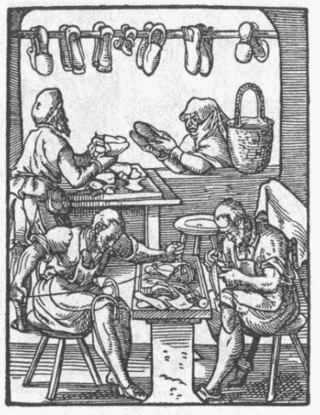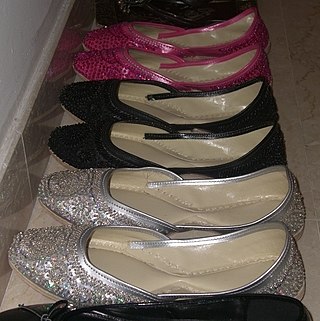
Neijia is the collective name for the internal Chinese martial arts. It relates to those martial arts occupied with spiritual, mental or qi-related aspects, as opposed to an "external" approach focused on physiological aspects. The distinction dates to the 17th century, but its modern application is due to publications by Sun Lutang, dating to the period of 1915 to 1928. Neijing is developed by using neigong or "internal changes", contrasted with waigong or "external exercises".

A shoe is an item of footwear intended to protect and comfort the human foot. Though the human foot can adapt to varied terrains and climate conditions, it is vulnerable, and shoes provide protection. Form was originally tied to function but over time shoes also became fashion items. Some shoes are worn as safety equipment, such as steel-toe boots, which are required footwear at industrial worksites.

Footwear refers to garments worn on the feet, which typically serve the purpose of protection against adversities of the environment such as wear from rough ground; stability on slippery ground; and temperature.

Tabi are traditional Japanese socks worn with thonged footwear such as zori, dating back to the 15th century.

Slippers are a type of shoes falling under the broader category of light footwear, that are easy to put on and off and are intended to be worn indoors, particularly at home. They provide comfort and protection for the feet when walking indoors.

Zori, also rendered as zōri, are thonged Japanese sandals made of rice straw, cloth, lacquered wood, leather, rubber, or—most commonly and informally—synthetic materials. They are a slip-on descendant of the tied-on waraji sandal.

Sandals are an open type of shoe, consisting of a sole held to the wearer's foot by straps going over the instep and around the ankle. Sandals can also have a heel. While the distinction between sandals and other types of footwear can sometimes be blurry, the common understanding is that a sandal leaves all or most of the foot exposed. People may choose to wear sandals for several reasons, among them comfort in warm weather, economy, and as a fashion choice. Usually, people wear sandals in warmer climates or during warmer parts of the year in order to keep their feet cool and dry. The risk of developing athlete's foot is lower than with enclosed shoes, and the wearing of sandals may be part of the treatment regimen for such an infection.

Shoemaking is the process of making footwear.

Combat boots are military boots designed to be worn by soldiers during combat or combat training, as opposed to during parades and other ceremonial duties. Modern combat boots are designed to provide a combination of grip, ankle stability, and foot protection suitable for a rugged environment. They are traditionally made of hardened and sometimes waterproofed leather. Today, many combat boots incorporate technologies originating in civilian hiking boots, such as Gore-Tex nylon side panels, which improve ventilation and comfort. They are also often specialized for certain climates and conditions, such as jungle boots, desert boots, and cold weather boots as well as specific uses, such as tanker boots and jump boots.

Opanci are traditional peasant shoes worn in Southeastern Europe. The attributes of the opanci are a construction of leather, lack of laces, durable, and various endings on toes. In Serbia, the design of the horn-like ending on toes indicates the region of origin, though this specific design is not exclusive to Serbia. The opanci are also considered as the traditional peasant footwear for people in the Balkan region. In Bulgaria they are referred to as "tsarvuli".

Galoshes, also known by many other names, are a type of overshoe or rubber boot that is slipped over shoes to keep them from getting muddy or wet during inclement weather.

The Papal slippers are a historical accoutrement worn by the Pope. The papal slippers were a form of episcopal sandals worn by bishops. However, unlike the episcopal sandals, which change with the liturgical colour, the papal slippers were always red.

Imperial Japanese Army uniforms tended to reflect the uniforms of those countries who were the principal advisors to the Imperial Japanese Army at the time.

The juti or jutti is a type of footwear common in North India, Pakistan, and neighboring regions. They are traditionally made up of leather and with extensive embroidery, in real gold and silver thread as inspired by royalty in the subcontinent over 400 years ago. Prior to that, Rajputs of the northwest used to wear leather juttis, also called ethnic shoes. Now with changing times, different juttis with rubber soles are made available.Today Amritsar and Patiala are important trade centers for handcrafted juttis, from where they are exported all over the world to Punjabi diaspora. Closely related to mojaris. Jutis have evolved into several localized design variations, even depending upon the shoemaker. However by large, they have no left or right distinction, and over time take the shape of the foot. They usually have flat sole, and are similar in design for both women and men, except for men they have a sharp extended tip, nokh curved upwards like traditional moustaches, and are also called khussa, and some women’s jutis are backless. Even with changing times jutis have remained part of ceremonial attire, especially at North Indian weddings, the unembellished juttis are used for everyday use for both men and women in most of Punjab, mostly called Jalsa Jutti which is blackish in color.
The United States Army in World War II used a variety of standard and non-standard dress and battle uniforms, which often changed depending upon the theater of war, climatic environment, and supply exigencies.

A ballet shoe, or ballet slipper, is a lightweight shoe designed specifically for ballet dancing. It may be made from soft leather, canvas, or satin, and has flexible, thin full or split soles. Traditionally, women wear pink shoes and men wear white or black shoes. Skin-colored slippers—which are unobtrusive and thus give the appearance of dancing barefoot—are worn in modern ballets and sometimes modern dancing by both men and women.

A dress shoe is a shoe to be worn at smart casual or more formal events. A dress shoe is typically contrasted to an athletic shoe.

Jika-tabi are a style of footwear with a divided toe, originating in Japan. They are similar to tabi socks in both appearance and construction. Though they can be worn with traditional thonged footwear such as geta and zōri, jika-tabi are mostly designed and made to be worn alone as outdoor footwear, resembling boots that reach roughly to the mid-calf. Jika-tabi are also known as 'tabi boots'.

Ciocia is a kind of Italian footwear, now typically associated with the rural population of mountainous areas of Italy and the western Balkans. The traditional form of ciocie are made with large leather soles, tied to the leg by straps bound between the ankle and the knee. Rather than socks, a large piece of loose cloth was placed around the feet, ankles, and calves under the ciocie.
Feiyue is a Chinese shoe brand founded in Shanghai owned by Dafu Rubber Co., Ltd. The brand was acquired by Feiyue International, a subsidiary of BBC International LLC in 2014.




















